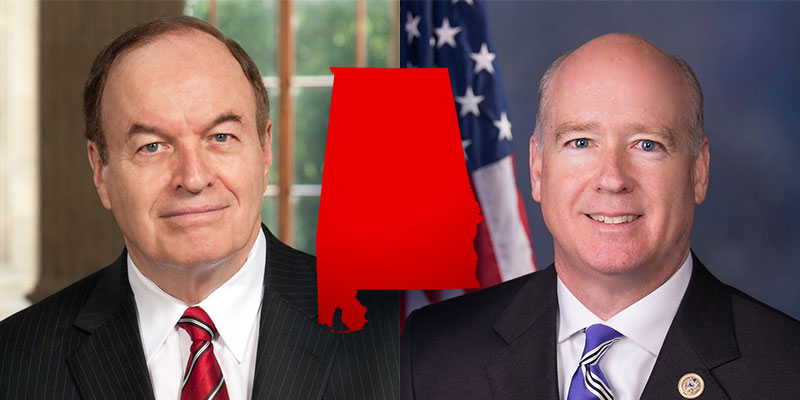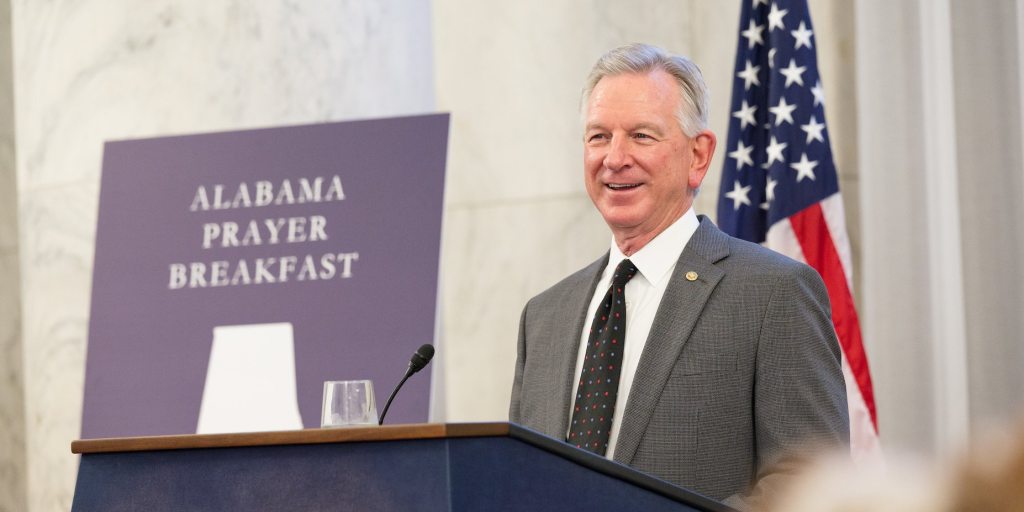The U.S. House of Representatives and Senate on Monday both voted to pass an omnibus appropriations package that contains all 12 Fiscal Year 2021 (FY21) spending bills and majorly benefits Alabama.
The comprehensive legislation, the Consolidated Appropriations Act of 2021, also included about $900 billion in additional COVID-19 relief for struggling Americans and businesses. The measure was passed in the Senate by a vote of 92-6.
The package was passed by the House of Representatives in two separate votes. One vote was on the portion of the bill for the appropriations for some federal departments including Commerce, Justice, Defense, Treasury, and Homeland Security, and some federal components including the White House and the District of Columbia. No member of Alabama’s House delegation voted against this portion. However, Congressman Mo Brooks (AL-05) voted against the other portion of the legislation, which contained appropriations for the remainder of the federal government as well as coronavirus stimulus and relief and many other miscellaneous provisions. Congressman Mike Rogers (AL-03) did not vote on either portion as he continues to isolate while having the coronavirus.
U.S. Senator Richard Shelby (R-AL), as the powerful chairman of the Senate Committee on Appropriations and its subcommittee on defense, had a leading role in crafting the appropriations aspect of the bill.
“This is great news,” said Shelby in a statement after the legislation passed the Senate. “I am pleased we swiftly advanced this package through Congress and on to the President’s desk. The American people expect us to do our job, and funding the government, including the military, is our fundamental responsibility. This package not only includes FY21 appropriations bills, but it also provides COVID relief for struggling American families, workers, and businesses. This is paramount as our nation works to recover from the pandemic. This year has been unprecedented in a number of ways. Completing our work is all the more important.”
Congressman Robert Aderholt (AL-04) — the dean of Alabama’s House delegation, a senior member of the House Committee on Appropriations and the ranking member of its Subcommittee on Commerce, Justice and Science — also had an outsized role. Outgoing Congresswoman Martha Roby (AL-02) is also a member of the lower chamber’s Committee on Appropriations.
Overall, the Shelby-led appropriations package featured FY21 funding that significantly supports the Yellowhammer State across the areas of defense, aerospace, medical research, agriculture and much more.
“Alabama’s skilled workforce has a far-reaching impact on the entire nation. The funding in this appropriations package shows just that – that Alabama remains at the forefront and leads in many areas, such as missile defense, space exploration, medical research, and manufacturing, to name a few,” Shelby added. “This legislation makes certain that Alabama will remain a major player on the national stage. I look forward to its lasting influence on our state and our nation.”
Shelby’s office outlined the following provisions impacting Alabama (broken down by the respective Appropriations subcommittees):
Agriculture, Rural Development, Food and Drug Administration, and Related Agencies:
- $175 million for Watershed and Flood Prevention Operations; including language to exempt watershed projects that impact areas greater than 250,000 acres, which helps expand irrigation agriculture projects in Alabama.
- Provides funding to the Agricultural Research Service (ARS), which supports current research initiatives at Auburn University:
- $4 million for aquaponics system development;
- $5 million to combat cotton blue disease;
- $3 million for advanced poultry production technology development;
- $2 million for advancing efficiency of forage-based beef production;
- $1.5 million for alternative technologies for poultry waste utilization;
- $1.2 million to study harmful algal bloom impact on aquaculture;
- $1 million for dietary manipulation to improve gut health in broiler production;
- Maintains funding for foodborne pathogens and shrimp production research; and
- $1.5 million for the establishment of a center of excellence for Animal Health and Agro-Bio Defense science, which Auburn University supports through the development of the National Bio and Agro-Defense facility.
- $3 million in grant funding for the Animal and Plant Health Inspection Service (APHIS) to develop a new pilot program to assist statewide departments of agriculture and forestry commissions, including the Alabama Forestry Commission, in controlling the spread of cogongrass.
- $1 million for the Food and Drug Administration (FDA) to develop research, education, and outreach partnerships with academic institutions to study and promote seafood safety, which will benefit ongoing research at the Dauphin Island Sea Lab.
- $5 million for Rural Development to coordinate with Southeastern universities on a pilot program to develop innovative rural wastewater treatment solutions for communities with untreated sewage issues, such as the Black Belt region of Alabama.
Commerce, Justice, Science and Related Agencies:
Department of Commerce:
- $34.5 million to support staffing and operations at the National Water Center (NWC), which is located in Tuscaloosa, Alabama.
- $15 million for the establishment of a new National Oceanic and Atmospheric Administration (NOAA) Cooperative Institute to help NOAA and the National Water Center address the nation’s growing water-related challenges.
- $2.5 million to conduct an independent population assessment of greater amberjack in the Gulf of Mexico.
- $7 million to ensure successful implementation of “Reef Fish Amendment 50,” which delegates the federal management of red snapper to the Gulf Coast states.
- $2.6 million for National Oceanic and Atmospheric Administration (NOAA) to implement and enforce the Seafood Import Monitoring Program.
Department of Justice:
- $566 million for FBI construction, which supports ongoing and growing efforts in Huntsville.
NASA:
- $6.5 billion for space exploration, which includes $2.6 billion for the Space Launch System (SLS) program and $850 million for the Human Landing System, both of which are managed by Marshall Space Flight Center in Huntsville and are critical to the development and sustainment of the nation’s human exploration goals.
Energy and Water Development:
Army Corps of Engineers:
- $50 million for the operations and maintenance of Donor and Energy Transfer Ports, which benefits the Port of Mobile.
- $5 million for the Regional Sediment Management Program, which benefits research conducted at the National Water Center in Tuscaloosa related to enhancing forecasting capabilities and coastal resilience.
- $8.55 million for the Coastal Inlet Research Program, which supports collaboration with the Army Corps of Engineers and the National Water Center to address coastal resilience needs, measure coastal forces, and improve terrestrial and coastal modeling.
- $6.2 million for the Army Corps of Engineers to continue research on the impact of reduced lock operations on riverine fish, which is in collaboration with Auburn University.
Department of Energy:
- $25 million for EPSCoR program, which provides federal support for sustainable and competitive energy research in eligible states and territories.
- Provides funding for the National Carbon Capture Center, which is located in Wilsonville, Alabama.
Independent Agencies:
- $30 million for the Delta Regional Authority, including $15 million for flood control projects, basic public infrastructure development, and transportation improvements.
- $180 million for the Appalachian Regional Commission, including $55 million for the POWER Initiative that provides federal funding to help communities and regions affected by job losses in coal mining and coal power plant operations.
Interior, Environment and Related Agencies:
- $25 million for the Fish and Wildlife Service to combat Asian Carp and enhance efforts in sub-basins of the Mississippi River, which includes key areas of Alabama in the Tennessee and Cumberland basins.
- $2 million for downed timber research, which supports work conducted at Auburn University.
- $25.5 million increase for U.S. Geological Survey Water Resources for staffing related to the Hydrologic Instrumentation facility, which is co-located at the University of Alabama.
Labor, Health and Human Services, Education, and Related Agencies:
- $42.9 billion for the National Institutes of Health (NIH), an increase of $1.25 billion above FY20 funding level. This funding will help increase and build on the $350 million that Alabama universities received in FY20 for medical research.
- $6.56 billion for the National Cancer Institute (NCI), an increase of $119.4 million from FY20.
- $45 million to the National Institute on Minority Health and Health Disparities (NIHMD) for chronic disease centers, which supports research at the University of Alabama at Birmingham (UAB).
- $855.4 million for the National Center for Advancing Translational Sciences (NCATS), an increase of $22.5 million.
- $586.8 million for Clinical and Translational Science Awards (CTSAs), an increase of $18.8 million from FY20, which continues funding for a $50 million CTSA award at UAB.
- $10 million in grant funding for Regional Pediatric Pandemic Network for Children’s Hospitals.
- $40 million in targeted funding for Regional Biocontainment Laboratories to test FDA-approved drugs.
- $1.68 billion in funding for Community Health Centers, an increase of $57.3 million, which will help fund 126 community health centers in rural areas across Alabama.
- $350 million in grant funding for Children’s Hospitals Graduate Medical Education, an increase of $10 million, which will increase Pediatric residencies at Children’s & Women’s Hospital in Mobile and Children’s of Alabama in Birmingham.
- $24.8 million for Poison Control Centers, an increase of $2 million, which supports Alabama’s Poison Control Center located in Birmingham and is affiliated with Children’s of Alabama.
- $35 million in continued funding for Department of Labor Workforce Opportunities in the Delta Regional Authority and Appalachian Regional Commission regions, an increase of $5 million, which funds workforce development initiatives throughout the state.
- $185 million for industry recognized apprenticeship grants, an increase of $10 million, allowing Alabama’s Community College system the ability to tailor programs directly with employers for enhanced training and certifications.
- $440 million for charter schools, which continues to fund University Charter School in Livingston, Alabama, and could potentially expand charter schools throughout the state.
Transportation, Housing and Urban Development, and Related Agencies:
- $30 million for Alabama’s Northern Beltline of the Appalachian Development Highway System.
- $1 billion for the Better Utilizing Investments to Leverage Development (BUILD) grant program, which provides federal investment to support road, rail, transit, and port projects.
- $1 billion for the INFRA grant program, which provides federal funding for highway and freight projects of national and regional significance.
- $18 billion for the Federal Aviation Administration (FAA), which provides assistance for Alabama airports, including:
- Grants-in-aid for airports;
- Contract towers;
- Research for advanced materials and structural safety;
- Research on airfield pavement; and
- Aviation workforce grants.
Defense / Homeland Security / Military Construction, Veterans Affairs and Related Agencies:
Impacting the Wiregrass region:
- $1.2 billion for flight training at Fort Rucker to address the Army pilot shortage.
$717.9 million for Future Vertical Lift research, which will accelerate the development of helicopters flown at Fort Rucker, and an additional $90.5 million to accelerate the Future Long Range Assault Aircraft.
- $48 million for United States Coast Guard MH-60T sustainment.
- $131 million to upgrade the MH-60 series helicopters.
- $578 million for Terminal High Altitude Area Defense (THAAD) missiles.
- $196 million for Joint Air-to-Ground Missiles (JAGMs).
- $470 million for Joint Air-Surface Standoff Missile (JASSMs) and $134 million for Long Range Anti-Ship Missiles (LRASMs).
- $91 million for Hellfire missiles, which are made in Troy and used for training at Fort Rucker.
- $200 million for Javelin missiles for the Army and Marine Corps.
Impacting North Alabama:
- Army Research – $13.9 billion, an increase of $1.4 billion from FY20, for investments in transformational technologies to address modern and future Army warfighting needs.
- Missile Defense – $10.46 billion for the Missile Defense Agency (MDA), which is located in Huntsville, to ensure support for urgent MDA unfunded priorities such as space sensors, hypersonic defense, and cybersecurity.
- Hypersonic weapons – fully funds Army hypersonic research, which is an increase of $461.4 million above the FY20 enacted level, as well as an additional $60 million to develop a common hypersonic glide body and $47 million to advance hypersonic testing infrastructure.
- Cyber – $430 million to support the Department of Defense’s 5G program.
Impacting Anniston:
- $19 million for Federal Emergency Management Agency’s (FEMA) Center for Domestic Preparedness for capital improvements and infrastructure modernization, including $10.6 million for high priority maintenance and operational requirements for the Federal Incident Workforce Academy.
- $125 million for Hydra rockets, which are built in Anniston and fired from Army and Marine Corps helicopters.
- Funding for Army vehicles overhauled and maintained at Anniston Army Depot (ANAD), including:
- $968 million to continue upgrading and modernizing the M1 Abrams tanks;
- $1.1 billion for Stryker vehicle upgrades;
- $463 million for Paladin Integrated Management artillery vehicles; and
- $188 million for a Demilitarization Facility at Anniston Army Depot.
Impacting Mobile’s shipbuilding industry:
- One additional Expeditionary Fast Transport (EPF) ship with increased medical capabilities, as well as $50 million to explore autonomous proficiencies for existing EPF ships.
- An additional $500 million for LHA-9, an amphibious assault ship.
Other miscellaneous items:
- $11.6 million for a new F-35 Simulator Facility at Montgomery Regional Airport Base.
- $18 million for a Demilitarization Facility at Anniston Army Depot.
- $34 million for the Secret Service’s National Computer Forensics Institute, located in Hoover, to expand training opportunities for state and local law enforcement and legal and judicial professionals in computer forensics and cyber investigations.
- $15 million for the Department of Homeland Security’s Explosive Detection Canine Program, which was developed in collaboration with Auburn University.
Aderholt’s office also highlighted some additional measures that the Republican congressman championed in the package. The legislation included: an increase of $2 million for VORTEX-SE and the study of tornado development in Alabama; $635 million for the Rural Broadband ReConnect program which Aderholt helped create; a $300 million broadband deployment program at NTIA to support broadband infrastructure deployment to unserved areas, prioritizing unserved areas and areas that are more rural; and an increase for the Debbie Smith DNA Backlog Grant program by $8 million, bringing the funding total to $110 million.
The COVID-relief portion of the package included an extension of the Paycheck Protection Program (PPP), funding for vaccine production and distribution, stimulus checks and a temporary extension of a number of unemployment programs created by the CARES Act. Further, the legislation contained $13 billion to support farmers and agriculture impacted by the pandemic.
“This is a win for the American people and a defeat for left-leaning special interests in our country,” Aderholt said in a statement of his own. “This spending bill provides important support for small businesses that have been hurt during this pandemic and provides another round of direct payments to the American people that will help us get through this difficult time and help to shore up our economy. There are important funding increases for NASA, protections for rural hospitals, and increases in rural broadband funding. It also prioritizes our national security and continues to fund the construction of the border wall.”
“Just as important as the items included in this bill are the things that were not included,” he continued. “The Democrats wish list items of defunding the police, restricting Second Amendment rights and taxpayer funded abortions have all been eliminated. Also, Democrats pushed hard for bailouts for states that have mismanaged their economies and they expected taxpayers in states like Alabama to foot the bill. Republicans successfully removed all of these items.”
Aderholt concluded, “I’m disappointed that it has taken Democrats so long to finally negotiate a deal that helps the American people. They held on to their liberal wish list for far too long. This should have been done months ago. I’m hopeful that in the future we can get spending bills completed on time and within regular order.”
Congressman Gary Palmer (AL-06) is the fifth-highest ranking GOP member of the House in his role as chairman of the Republican Policy Committee.
He released the following statement following his votes to support the comprehensive legislation on Monday:
This bill includes additional COVID-19 relief funding, which includes additional Payroll Protection Program (PPP) dollars, vaccine development and distribution funding, and deductibility for businesses that utilized the first rounds of PPP loans. It also contains provisions based on legislation that I introduced, including allowing families with unused funds in Flexible Spending Accounts to carry over those funds to 2021 instead of losing them at the end of 2020, requiring states to set more stringent safeguards against fraudulent unemployment claims, and extending the length of time for states to utilize the funding they received in the CARES Act that was set to expire on December 30th.
This legislation authorizes $900 billion in relief spending, but over $560 billion of that is repurposed funding that had already been appropriated. From the very beginning of the negotiations, I advocated for utilizing $137 billion of unused PPP funds and $429 billion of unused Main Street Program funds being held by the Treasury Department to reduce the amount of new spending.
Additional relief should have been passed months ago, but Speaker Pelosi held it hostage, despite the great harm to American families and businesses. Throughout this process, Pelosi has used American families and businesses for political advantage, and people across the country have paid a high price. Pelosi and her Democrat colleagues should pay the price for what they did.
Sean Ross is the editor of Yellowhammer News. You can follow him on Twitter @sean_yhn












